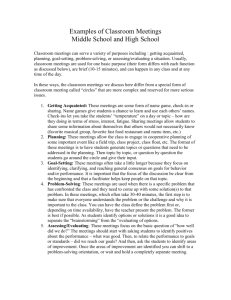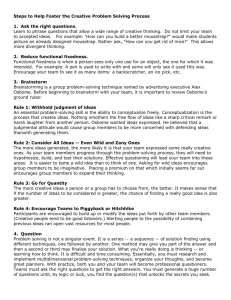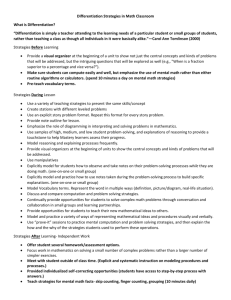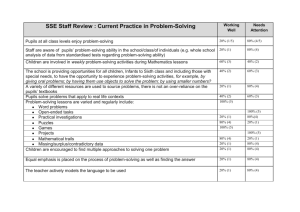Six Problem Solving Fundamentals
advertisement
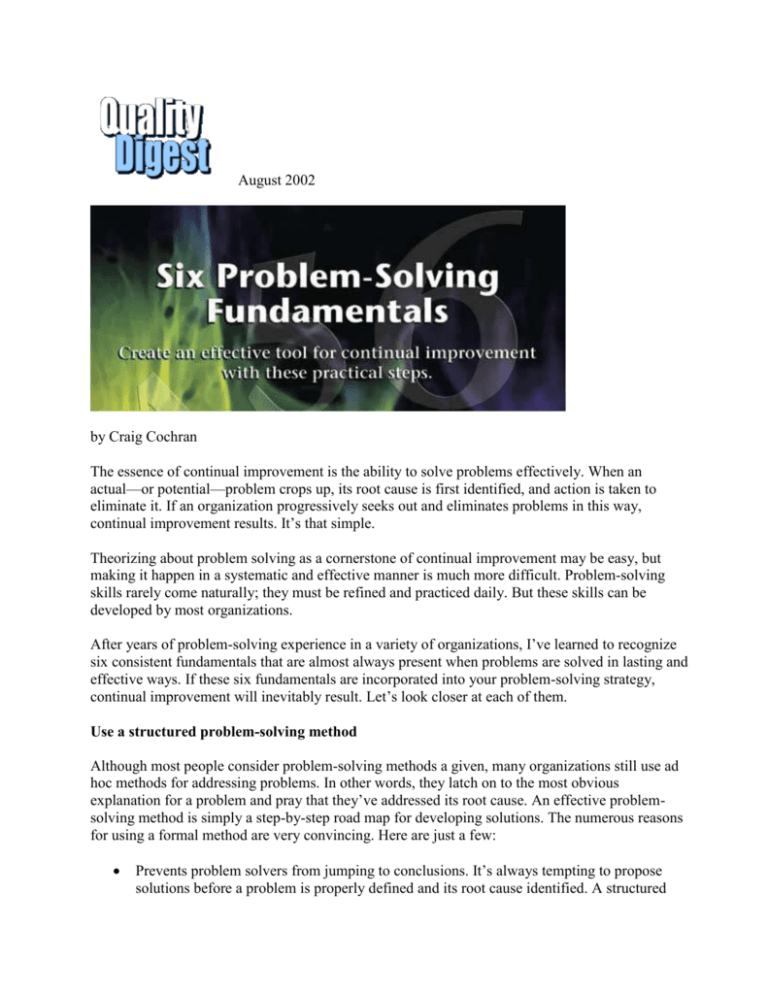
August 2002 by Craig Cochran The essence of continual improvement is the ability to solve problems effectively. When an actual—or potential—problem crops up, its root cause is first identified, and action is taken to eliminate it. If an organization progressively seeks out and eliminates problems in this way, continual improvement results. It’s that simple. Theorizing about problem solving as a cornerstone of continual improvement may be easy, but making it happen in a systematic and effective manner is much more difficult. Problem-solving skills rarely come naturally; they must be refined and practiced daily. But these skills can be developed by most organizations. After years of problem-solving experience in a variety of organizations, I’ve learned to recognize six consistent fundamentals that are almost always present when problems are solved in lasting and effective ways. If these six fundamentals are incorporated into your problem-solving strategy, continual improvement will inevitably result. Let’s look closer at each of them. Use a structured problem-solving method Although most people consider problem-solving methods a given, many organizations still use ad hoc methods for addressing problems. In other words, they latch on to the most obvious explanation for a problem and pray that they’ve addressed its root cause. An effective problemsolving method is simply a step-by-step road map for developing solutions. The numerous reasons for using a formal method are very convincing. Here are just a few: Prevents problem solvers from jumping to conclusions. It’s always tempting to propose solutions before a problem is properly defined and its root cause identified. A structured problem-solving method prevents the process from short-circuiting and ensures the critical, preliminary step of truly understanding the problem and its variables. Ensures root cause analysis. An inability—or unwillingness—to identify the root cause is probably the single biggest obstacle to problem solving. However, when one of the explicit steps of a structured problem-solving method is identifying the root cause, it’s much harder to ignore. Demystifies the problem-solving process. When each step of the problem-solving method is understood and agreed upon by all participants, the process gives everyone an opportunity to contribute and drives a team-oriented style of problem solving. Prescribes which analytical tools to use and when. The sheer number of analytical tools available to problem solvers is mind-boggling, and it’s not always clear when the use of a certain one is appropriate. A structured problem-solving method offers guidance on when and how to use the proper tools. Along with the numerous analytical tools available, there are many structured problem-solving methods. Some are copyrighted, some are public domain, some are very intricate and others are quite simple. Typically, they range in complexity from four to eight steps, but all the methods share the same basic themes. Therefore, it’s less important which problem-solving method you choose than actually picking one and using it. You can even make up your own method. But for those who aren’t feeling particularly creative, you’re welcome to adopt the strategy outlined below. This is a basic problem-solving method that accommodates my own sensibilities and provides for all the necessary activities. 1. Decide on which problem to pursue. For some reason, this step is left out of many problemsolving methods. Maybe it’s assumed that participants will automatically know which problems are worth tackling. This is hardly ever the case. In most organizations there are countless opportunities for improvement but finite resources available to apply to them. Most organizations must prioritize the issues and dedicate resources accordingly. (Appropriate tools for this step include brainstorming, Pareto charts, run charts, pie charts, flowcharts and voting.) 2. Define the problem. In the clearest and most succinct terms possible, what exactly is the problem? Provide the details of who, what, where and when. "The customer states that the parts won’t run right," is an almost-worthless problem definition. Get specific. Keep in mind that carefully defining the problem will provide the raw material for successfully identifying its root cause. (Appropriate tools include brainstorming, Pareto charts, check sheets and histograms.) 3. Determine the root cause. Identifying a root cause proceeds directly from defining the problem itself. The typical obstacle at this step is mistaking a symptom for the root cause. Often the so-called "root cause" is nothing more than a restatement of the problem definition. Before team members are asked to participate in problem solving, they should receive training in how to distinguish symptoms from root causes. (Appropriate tools include interviewing, brainstorming, cause-and-effect diagrams, and voting.) 4. Generate possible solutions and choose the most likely one. This step works very well in a team setting, where it’s possible to generate a large number of alternative solutions. The trick is to cast a wide net, then narrow the possibilities to those solutions that satisfy the following criteria: They have a strong chance of being successfully implemented, they will be accepted by all relevant stakeholders and they truly address the root cause identified in the previous step. Then agree upon a solution, either by group consensus or through executive decree. (Appropriate tools include brainstorming, Pareto charts and voting.) 5. Plan and execute the solution. Even the best solution is doomed to fail if its implementation isn’t carefully planned and executed. This process typically consists of two distinct phases: selling the solution to key stakeholders in order to get buy-in and methodical project planning to ensure the solution is executed correctly. It’s also helpful to notify the organization’s customers who will be affected by the solution. This reinforces the idea that the organization is dedicated to customer satisfaction and problem resolution. (Appropriate tools include project planning, effective presentation skills, selling skills and pilot runs.) 6. Verify effectiveness. After you’ve implemented your solution, someone must verify that it’s effective. The more objective this determination is, the better. It isn’t absolutely necessary that people outside the problem-solving team verify effectiveness, but it might be helpful in order to avoid bias. Whether they’re internal or external, customers are particularly good at shedding light in this regard. If a customer doesn’t perceive an improvement, then there is no improvement. Perception is everything. (Appropriate tools include auditing, interviewing, documentation, control charts and process capability.) 7. Communicate and congratulate. This step is routinely forgotten in many organizations. Most problem-solving methods I’ve seen don’t address this issue, even though communication drives an effort’s success at every stage. People crave information about how problems are being addressed and solved. This information creates a feeling of security and confidence and builds a culture of continual improvement. Recognition is also critical. People who successfully contribute to problem-solving efforts should be recognized for their work. Congratulations should be dignified, public and carried out by top management. (Appropriate tools include empathy, integrity, and effective speaking and writing skills.) Although the timeless quandaries of society might elude a structured problem-solving method, the majority of predicaments facing business organizations won’t. Select a problem-solving method and commit to using it at all levels of your organization. Then train everyone in the method and make it an institution. A tool of this sort gets stronger with regular use, so exploit every opportunity for applying it. Each of the following fundamentals could be considered components of the problem-solving method we just explored, but they’re still important enough to look at individually. Assign ownership of the problem Even if your organization uses a team approach to problem solving, every problem should be assigned to a specific individual. Confirm that this person accepts the ownership. The owner is simply the project manager for solving the problem. Make sure he or she understands that being selected as "problem owner" in no way indicates accusation or blame. In fact, it’s a vote of confidence in the person’s ability as a leader and manager. In a perfect world, problems assigned to committees would always get solved. This might even happen in our world occasionally. However, individuals who are accountable for projects lead the vast majority of successful problem-solving projects. Ownership can make remarkable things happen; don’t neglect it. Involve people familiar with the problem Those most familiar with the variables surrounding a problem should be involved in the problemsolving process. Often, these aren’t managers and supervisors but people taking orders, writing software, operating machines, driving forklifts and performing repairs. An organization’s culture must allow all personnel to contribute actively to the process, regardless of their level within the organization. One of the project manager’s most important tasks will be to select the right people for the problem-solving team. Participants should be told why they’ve been included (e.g., their technical expertise, familiarity with processes in question or experience in the department). It’s important that individuals are motivated and enthusiastic about being involved. Apply project management techniques Project management is a very basic concept. It simply means assigning responsibilities, timeframes, milestones and reviews—and then tracking them to completion. Following through on a complex initiative without project management becomes strictly a matter of luck; something that wise people won’t count on in a pinch. A well-designed corrective and preventive action system embodies the basics of project management. If your system is user-friendly and streamlined, then it’s perfectly suited as a projectmanagement tool for problem solving. If it’s not, then it should be redesigned—and fast. Complexity isn’t a positive attribute for corrective and preventive action systems. Benchmark systems from other organizations and don’t be afraid to borrow best practices where you find them. Aggressively pursue the root cause An explicit step of nearly all problem-solving models is identifying the root cause. But just because it’s explicit doesn’t mean it will happen. Identifying a problem’s true root cause must be encouraged, and it’s the project manager’s responsibility to see that this is done. Identifying a root cause isn’t easy; it usually takes some serious investigation and intellectual tenacity. Keep in mind that a root cause is rarely the first thing that comes to mind. Consider these supposed root causes: Employee error. It’s possible that employee error may have been a cause of a problem at hand, but is it the root cause? Why exactly did the employee make the error? Why is the task prone to error? Most likely, employee error isn’t the true root cause, and any corrective action directed at this mistaken assumption won’t make the problem go away. Failure to follow procedure. Why didn’t the employee follow procedure? Did he or she know that a procedure existed? Are there other forces at play, such as an incentive that discourages adhering to the procedure? The corrective action for "failure to follow procedure" is usually the old standby, "reprimand employee." Does anyone really believe that reprimands drive continual improvement? Not in any organization I’d want to be a part of. Employee not properly trained. If a training program exists, why was the employee not properly trained? The only reasonable corrective action for "employee not properly trained" is "conduct training." If the system is inherently flawed, however, no amount of training will remedy it. In fact, training in a flawed work method only reinforces the flawed method, guaranteeing more problems in the future. The examples above illustrate the elusive nature of root causes. Once you think you’ve identified the root cause, ask "why" one more time. You might be surprised to discover one more layer to the problematic onion. Communicate, communicate, communicate Make problem-solving success stories a frequent subject within your organization. If a customer complaint gets addressed effectively, tell the tale in the company newsletter. If a group of employees succeeds in reducing the error rate, send everyone an e-mail trumpeting the achievement. If the quality assurance department assists a supplier in improving the consistency of its output, ask the local newspaper to cover the story. Get the word out any time your organization succeeds in solving or preventing problems. The more often employees hear about successes, the more they’ll want to be involved. And the more they become involved, the more successful your company will become. Dignified public recognition is, of course, a form of communication, one that delivers an astronomical return on investment. The message underlying public recognition is "The company appreciates your team’s fine efforts, and we sincerely hope others will follow your example." Who wouldn’t want to follow their example and be recognized, too? About the author Craig Cochran is a project manager with the Center for International Standards & Quality, which is part of Georgia Tech’s Economic Development Institute. He holds an MBA from the University of Tennessee and is an RAB-certified QMS lead auditor. CISQ can be reached at (800) 859-0968 or on the Web at www.cisq.gatech.edu. Letters to the editor regarding this article can be sent to letters@qualitydigest.com.




